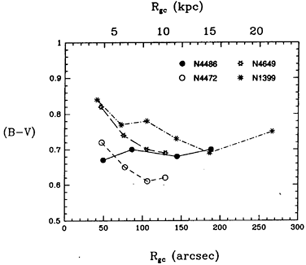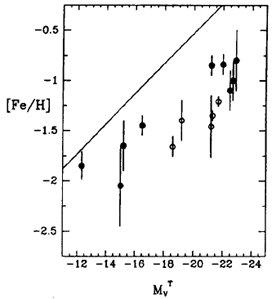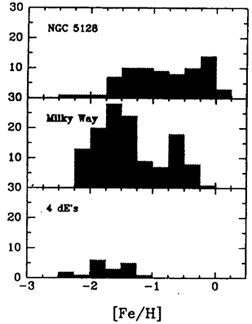Copyright © 1991 by Annual Reviews. All rights reserved
| Annu. Rev. Astron. Astrophys. 1991. 29:
543-79 Copyright © 1991 by Annual Reviews. All rights reserved |
The chemical compositions, and composition gradients, within the halos of galaxies trace out their early enrichment histories. The observable record (though not always an unambiguous one) lies in the integrated color indices and spectral features of the halo light and of the light from globular clusters. This type of approach to GCS properties was launched with the landmark papers of Strom et al. (192) and Forte et al. (64) on four Virgo galaxies including M87. Their UBR photographic photometry of these systems indicated both that the clusters were bluer on the average than the galaxy itself at any location and that the GCSs exhibited color gradients (bluer mean color at larger galactocentric radius Rgc). These results were interpreted to mean that the clusters had systematically lower metallicity than the field stars and became more metal-poor with increasing Rgc. In turn, such results supported the idea that the clusters were distinctly older than the bulk of the halo, and that the halo formed by collapse with dissipation and progressive metal enrichment. A calculation by De Young et al. (51) suggested that the clusters, by forming first, could have seeded the enrichment of the halo gas which only later condensed into stars, thus creating the observed metallicity offset between clusters and halo.
Subsequent observational work strengthened
the first of these two results. Mean color differences at the
same level, namely
 (B - V)(halo -
GCS)
(B - V)(halo -
GCS)  0.2-0.3 mag, also held in the dwarf ellipticals
(92), and later
CCD multicolor photometry for
GCSs in several giant ellipticals has verified both the sense
and the amount of the effect
(18,
38,
39,
40,
88).
The interpretation of color difference as primarily, or
entirely, a metallicity difference was at first more of
a reasonable hypothesis than a necessity. [See, for example,
the understandably skeptical view by Burstein (24).]
However, spectroscopic indices obtained for clusters in both
dwarf and giant galaxies (21,
45,
81,
119,
151,
152)
now more directly support this interpretation.
The mean spectroscopic
cluster metallicities equal those predicted from the
integrated colors (e.g. 39). In
addition, they show that the clusters are generally more
metal-poor by
0.2-0.3 mag, also held in the dwarf ellipticals
(92), and later
CCD multicolor photometry for
GCSs in several giant ellipticals has verified both the sense
and the amount of the effect
(18,
38,
39,
40,
88).
The interpretation of color difference as primarily, or
entirely, a metallicity difference was at first more of
a reasonable hypothesis than a necessity. [See, for example,
the understandably skeptical view by Burstein (24).]
However, spectroscopic indices obtained for clusters in both
dwarf and giant galaxies (21,
45,
81,
119,
151,
152)
now more directly support this interpretation.
The mean spectroscopic
cluster metallicities equal those predicted from the
integrated colors (e.g. 39). In
addition, they show that the clusters are generally more
metal-poor by  [Fe/H]
[Fe/H]  -0.5 than the spheroid
stars at the same Rgc - just the right amount to produce
the color differential. The same result has now been extended
to include the Fornax dwarf
(43,
55,
140,
176),
M31
(20,
54), and the
Milky Way spheroid itself (226).
An important implication of the halo/GCS metallicity offset is
that the spheroids of galaxies did not
build up principally from dissolved globular clusters, but
rather belong to a distinct stellar population with a
different chemical enrichment history.
-0.5 than the spheroid
stars at the same Rgc - just the right amount to produce
the color differential. The same result has now been extended
to include the Fornax dwarf
(43,
55,
140,
176),
M31
(20,
54), and the
Milky Way spheroid itself (226).
An important implication of the halo/GCS metallicity offset is
that the spheroids of galaxies did not
build up principally from dissolved globular clusters, but
rather belong to a distinct stellar population with a
different chemical enrichment history.
An alternate interpretation, though with much less
observational backing, is to make the clusters
bluer at the same metallicity by requiring them to be
younger than the halo. Models of integrated cluster color against age
(e.g. 19,
33,
37)
show that enormous age
differences (
 ~ 5-10) Gy are needed to
generate integrated color differences as large as
~ 5-10) Gy are needed to
generate integrated color differences as large as  (B - V) ~ 0.2-0.3 mag
in an old stellar population.
One piece of more direct evidence which might
favor lower age is the presence of line-strength anomalies
found in some M31 halo clusters
(20,
25,
198),
though other interpretations
involving composition or stellar population variations are
possible. The ultraviolet fluxes of the M31 clusters do not appear
to be unusual (42), and spectral indices
from a much larger new sample (21) suggest
a more normal picture except for apparent nitrogen enhancements that
may be primordial in origin.
(B - V) ~ 0.2-0.3 mag
in an old stellar population.
One piece of more direct evidence which might
favor lower age is the presence of line-strength anomalies
found in some M31 halo clusters
(20,
25,
198),
though other interpretations
involving composition or stellar population variations are
possible. The ultraviolet fluxes of the M31 clusters do not appear
to be unusual (42), and spectral indices
from a much larger new sample (21) suggest
a more normal picture except for apparent nitrogen enhancements that
may be primordial in origin.
The second principal suggestion of the Strom et al. work -
that of metallicity gradients in the GCSs - has since been
thrown into considerable confusion. Later CCD photometry in
both the BVI and gri bands (38,
39)
showed that the clusters in M87 exhibit no
trace of a color gradient, and that the Strom et al.
result was probably a residual artifact of photographic
calibration across a nonuniform background. In NGC 5128 also,
little net change in mean cluster metallicity with Rgc is
evident (85,
88).
However, recent BV photometry in three other large ellipticals,
[NGC 1399,
4649, and M49
(18, 40)]
has revealed GCS color gradients amounting to
 (B - V)
(B - V)  0.1 mag in all three over
Rgc from 3 to 10 kpc.
Figure 7 presents these schematically. Also, in
both the Milky Way (101, 225) and M31
(14,
20,
54,
188,
189),
slight gradients in mean cluster metallicity
seem to exist throughout the halo even
after the inner metal-rich disk globulars are excluded,
suggesting that some small amount of systematic dissipation
and enrichment took place during formation.
In summary, the metallicity gradients in GCSs do not
seem to correlate unambiguously
with any other obvious systemic features.
One might speculate that their presence or absence
may simply be a residual of the whole set of events that occurred during
galaxy formation (dissipative collapse, chaotic merger of
gaseous fragments, later mergers or accretion of formed
galaxies), which must have had different relative importances
from place to place (123).
0.1 mag in all three over
Rgc from 3 to 10 kpc.
Figure 7 presents these schematically. Also, in
both the Milky Way (101, 225) and M31
(14,
20,
54,
188,
189),
slight gradients in mean cluster metallicity
seem to exist throughout the halo even
after the inner metal-rich disk globulars are excluded,
suggesting that some small amount of systematic dissipation
and enrichment took place during formation.
In summary, the metallicity gradients in GCSs do not
seem to correlate unambiguously
with any other obvious systemic features.
One might speculate that their presence or absence
may simply be a residual of the whole set of events that occurred during
galaxy formation (dissipative collapse, chaotic merger of
gaseous fragments, later mergers or accretion of formed
galaxies), which must have had different relative importances
from place to place (123).

Figure 7. Color gradients in the GCSs of elliptical galaxies. The mean (B - V) color of the globular clusters around each of four giant E galaxies is plotted in radial bins. Error bars on each mean point are typically  (B - V) ~ ±
0.03 mag. In M87 (N4486), no
significant change in mean cluster color (metallicity) with
galactocentric distance Rgc is seen. In the other three,
a systematic decrease of (B - V) ~ ±
0.03 mag. In M87 (N4486), no
significant change in mean cluster color (metallicity) with
galactocentric distance Rgc is seen. In the other three,
a systematic decrease of  (B - V) (B - V)  0.1 mag over 0.1 mag over
 r ~ 10 kpc is
seen, corresponding to a decrease of
about -0.5 dex in [Fe/H]. Note that this graph is
indicative of only relative changes in color within each
system; the offsets between the different galaxies
are not significant because of zero-point uncertainties in the
photometry, which can amount to ± 0.05 mag per field (see
the references cited in the text). r ~ 10 kpc is
seen, corresponding to a decrease of
about -0.5 dex in [Fe/H]. Note that this graph is
indicative of only relative changes in color within each
system; the offsets between the different galaxies
are not significant because of zero-point uncertainties in the
photometry, which can amount to ± 0.05 mag per field (see
the references cited in the text).
|
A major result now well established is that both the
mean cluster metallicity and the cluster-to-cluster
scatter in metallicity increase with the host galaxy
size. The dEs hold uniformly metal-poor clusters (45).
In the Milky Way (5,
225,
226)
and M31
(20,
54),
the halo clusters fall generally in the
range -2  [Fe/H]
[Fe/H]
 -1, but a more
metal-rich subgroup appears within Rgc
-1, but a more
metal-rich subgroup appears within Rgc  4 kpc.
In the giant ellipticals, the systemic mean is
consistently near [Fe/H]
4 kpc.
In the giant ellipticals, the systemic mean is
consistently near [Fe/H]  -1, but the total range
is very large, with clusters extending up to solar metallicity and
perhaps higher
(71,
85,
151,
152).
Figure 8 illustrates these trends.
The correlation of mean [Fe/H] with MVT(galaxy)
has a slope of
-1, but the total range
is very large, with clusters extending up to solar metallicity and
perhaps higher
(71,
85,
151,
152).
Figure 8 illustrates these trends.
The correlation of mean [Fe/H] with MVT(galaxy)
has a slope of  0.15,
corresponding to a scaling of
mean heavy-element abundance Z with galaxy luminosity as
Z ~ L0.4. Furthermore, it is parallel to the
trend for the metallicities of the galaxies themselves, but simply offset to
a lower [Fe/H], suggesting that the enrichment processes were
similar in both types of old stellar populations.
The clear implication is
that the enrichment yield during cluster formation
went much farther toward completion in the
giant galaxies (see 148a).
0.15,
corresponding to a scaling of
mean heavy-element abundance Z with galaxy luminosity as
Z ~ L0.4. Furthermore, it is parallel to the
trend for the metallicities of the galaxies themselves, but simply offset to
a lower [Fe/H], suggesting that the enrichment processes were
similar in both types of old stellar populations.
The clear implication is
that the enrichment yield during cluster formation
went much farther toward completion in the
giant galaxies (see 148a).

| 
|
| Figure 8. Metallicity distributions for globular cluster systems. In the left panel, the mean [Fe/H] for the globular clusters in the galaxy (from Table 2) is plotted against galaxy luminosity MVT; filled symbols denote elliptical galaxies, and open symbols are spirals or irregulars. The solid line is the mean [Fe/H] vs. luminosity relation for the galaxies themselves (cf. 21); the GCSs fall along much the same slope, but displaced ~ 0.5 dex downward. If the spiral galaxies (open circles) were to be plotted by only their spheroidal luminosities excluding the disk, they would lie ~1-2 magnitudes further to the left and would fall much closer to the mean relation defined by the E galaxies. In the right panel, histograms of cluster metallicities are shown for a giant elliptical, NGC 5128; the Milky Way; and the four dwarf E galaxies in the Local Group. In the larger galaxies, the globular clusters are distributed more widely in composition and have a higher mean metallicity. For NGC 5128, the relative number of high-[Fe/H] clusters may in fact be underestimated, since no clusters from its central regions are included (cf. 85). | |
These observations are consistent with a picture in which protoclusters formed within dwarflike units with their own pre-enrichment histories (e.g. 148a, 186), or else over a time period long enough for the surrounding halo gas to have enriched significantly while clusters were condensing out. New direct evidence for an age range of perhaps ~ 2 Gy among the Milky Way halo globulars (e.g. 13, 130, 200) may also support such interpretations. In addition, the near-constancy of mean cluster luminosity in all types of galaxies (Figure 1) and the strong dependence of their metallicity on galaxy size (Figure 8) imply in tandem that the process of cluster formation ran almost independently of composition.
Another observational constraint on a smaller scale
is that globular clusters are individually quite
homogeneous in composition (with outstanding exceptions such
as  Cen), whereas in big
galaxies we find a large
cluster-to-cluster spread in metallicity. Whether or
not a protoglobular gas cloud can self-enrich while still remaining
bound and homogeneous then becomes an important issue for
theoretical modeling
(126,
127,
148,
153,
154,
155).
Whatever pre-enrichment
process went on to produce higher yield in the more
massive galaxies, the individual protoglobular clouds seem to
have remained well mixed while still gaseous.
Cen), whereas in big
galaxies we find a large
cluster-to-cluster spread in metallicity. Whether or
not a protoglobular gas cloud can self-enrich while still remaining
bound and homogeneous then becomes an important issue for
theoretical modeling
(126,
127,
148,
153,
154,
155).
Whatever pre-enrichment
process went on to produce higher yield in the more
massive galaxies, the individual protoglobular clouds seem to
have remained well mixed while still gaseous.
The metallicity distributions of clusters provide additional evidence that the giant galaxies did not simply accumulate by mergers of already-formed smaller ones. However, the idea of mergers of disk systems in which globulars were rarer to begin with is an attractive hypothesis (Section 4) for explaining the very low specific frequencies in some field ellipticals. The clusters in such galaxies should have lower mean metallicities than those in high-SN ellipticals of the same size, and direct measurements of their abundances should provide an interesting test.